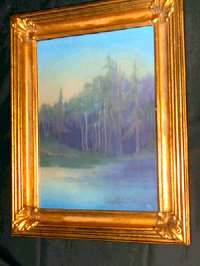Friday, December 12, 2003
While I don’t surf Ebay as often as I did four to five years ago, something highly interesting caught my eye last week.
I usually visit Ebay’s American Art Pottery categories and find a regular observation of items, sales (some things don’t sell) and prices achieved presents a more accurate reflection of the general market than most media analysis.

The Epply in question.
When surfing the Rookwood category last week I stumbled upon a Rookwood Vellum Plaque, dated 1916, by the highly desired Lorinda Epply being auctioned without a reserve.
Aside from her long career with the Rookwood Pottery, Ms. Epply is an important Cincinnati artist who excelled in other Arts and Crafts media and commands excellent prices for her work.
Epply made some superb and rare engravings, working with E. T. Hurley and his wife Irene Bishop, some on hand-crafted paper. She taught weaving and enjoyed batik and leather crafts.

High School graduation?
Her face in youth and old age appears kind and I would imagine she occasionally spoke her mind.
Like the other older, great and previously deceased Rookwood artists Hurley and Shirayamadani, Ms. Epply died July 18, 1951, within a few years of the Art Department's final elimination at Rookwood in 1948.
Epply was a graduate of Cincinnati's Woodward High School and attended the Cincinnati Art Academy.
She was a member of the Women's Art Club and the Cincinnati Crafters.
A “reserve” is a sort of pre-established safe bet for a seller.
Items with a reserve do not sell unless bids reach the amount of the reserve.
Though pictured without its gilt gesso frame in the initial photographs that are no longer available through Ebay, the large, 9 ¼” x 12 ½”, plaque with the unusually limited depth of the subject matter seemed terribly familiar.
As I scrolled through the professional quality photos I read a bit of curious text by the genderless shop-named Ebay Power Seller:
AFTER NUMEROUS INQUIRIES ON THIS PLAQUE WE HAVE CHECKED WITH A BLACK LIGHT FOR REPAIRS AND FOUND THAT IT COULD HAVE BEEN PROFESSIONALLY REPAIRED YEARS AGO
Standing alone a reference to a method of determining hidden ceramic repair would not be unusual, particularly, as a black light is a common if not completely effective detection tool. Rather, it was the phrase “AFTER NUMEROUS INQUIRIES” along with the plaque’s familiarity and that big gesso frame that got me to thinking, “Who could have inquired prior to the items posting? Kreskin?” I began to think the plaque had been unsuccessfully offered for sale in a non-virtual environment
A bit more thinking and likely some coffee and a nosh and I had it.
I had seen the plaque before.
It had, again, been for sale on Ebay!
I had written the seller and published a brief posting (this link and scroll to March 19) two days after it sold on March 17, 2003 for $7,800.
The March 17th sale made no mention of black lights or possible repair and, among the 21 bidders, I could tell were some big guns from the American Art Pottery Association.
The seller, then, answered my email promptly with a friendly reply.
He struck me as a nice guy and presented himself as more a dabbler than a professional antique seller. I was happy for him and his profitable transaction.
The bidding, when I noticed the plaque last week was, without a reserve, around $3.5K.
Ever the curious blogger, especially when the item’s history became clear, I decided to write the new seller.
I wanted, very deferentially, to know why the seller referenced a black light as well as the possibility of professional repair and if there was any nervousness selling without the safety net of a reserve.
This new seller did not reply.
The plaque, receiving only seven bids, sold five days ago for $4,803.53 with a loss of $2,996.47 considering the March 17th hammer price.
Clearly, considering the unique nature of these plaques, this could not have been a duplicate item.
Something clearly happened between March 17th and December 7th.
A seller certainly could have sold without knowing anything about previous repaired damage.
Anyone shopping on Ebay must consider that a nice looking online photograph is no substitute for a real time examination.
No matter a previous seller’s intention, damage once discovered by a buyer cannot be undiscovered.
Prospective Ebay buyers, particularly in these tough times, must be prepared for worst-case scenarios!
I wish the seller had not sustained this loss.
Had I purchased this plaque I would have been devastated to discover damage or a previous undescribed repair. Upon calming myself, I would have taken the plaque to a ceramic conservator for a professional exam. The best, in my opinion, is Wiebold’s here in Cincinnati.
A proper restoration by recognized conservators would restore some of the value lost when damage or a repair was discovered.
After the restoration I would, if purchased for resale, hold the plaque for, at least, several years or until I could be somewhat assured that I could recover my original and restoration expenditures.
Of course, I would not have purchased something unless I felt its beauty transcended any possibly hidden negative. Additionally, I would not have purchased at that price point, as they say on QVC, without extensive correspondence with the seller.
Buyers beware!
Photos: Kurt Harrison, Rookwood Pottery Potpourri
Reference: Rookwood Pottery Potpourri, Virginia Raymond Cummins

